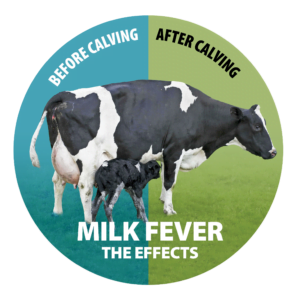
BEFORE CALVING
Increased Calcium Demand
- During the last weeks of pregnancy, the demand for calcium increases significantly for colostrum production and the developing calf requires large amounts of calcium for bone growth.
- When blood calcium levels drop rapidly, it can lead to milk fever.
Failure to contract smooth muscle
- Low blood calcium makes it difficult for the cow to contract smooth muscle, which can mean she has:
- Difficulty calving – more assisted calving’s are required as the cow struggles to push the calf out.
Assisted or long calving also increases the risk of uterine infections (metritis) and leads to reproductive challenges - Difficult to contract the teat sphincter, increasing the risk of mammary infections (mastitis)
- Reduced rumen muscle contractions, meaning poor feed digestion and increasing risk of rumen acidosis as the rumen has difficulty moving acids to the rumen wall for removal.
Decreased appetite
- The reduced appetite is partly due to the cow’s weakened state, but it is also a result of the cow’s body redirecting calcium from the digestive tract to the bloodstream. Weight loss leads to:
- Reduced milk production after calving
- Weakened immune system
- Reduced fertility
- Impaired digestive function
- Decreased muscle mass + mobility
- Increased the risk of ketosis and other disorders.
Mobilising its own body fat
- Just before calving, feed intake declines by 30% whilst energy requirements increase by 50%.
- A cow will mobilise its own body fat stores to meet energy needs.
- This results in a condition called ketosis, which causes appetite drop, weight loss, decreased milk production, and even death.
Weakness and lethargy
- This weakness can affect the cow’s ability to stand up or move around, making them more susceptible to injuries,
- When she’s down for long periods of time, paralysis can occur.
AFTER CALVING
Reduced fertility
- When calcium levels drop, a number of physiological changes occur that affect a cow’s reproductive system.
- Milk Fever delays the onset of ovarian activity after calving.
- This delay can result in longer intervals between calvings, which can reduce overall herd productivity.
- Uterine infections and retained placentas can also occur, further increasing the risk of infertility.
Heightened risk of other sicknesses
Because calcium plays a crucial role in immune function, Milk fever can weaken the cow’s immune system, making her more susceptible to a range of other health issues after calving:
- Retained placenta
- Metritis
- Poor udder health
- Mastitis
Milk production down 2.2L per cow/day for the entire lactation
- Calcium is an essential nutrient for the proper function of the mammary gland and the synthesis of milk.
- Clinical milk fever is reported to reduce milk production by 2.2L per cow/day
- The hormone prolactin, which is necessary for milk production, decreases, even after calving. This can result in a lower milk yield for the entire duration of the lactation period (280+ days).
